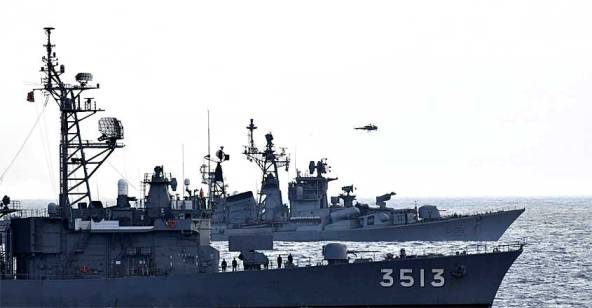
Indian and Japanese warships conducted exercises in the Indian Ocean on Saturday, announced the navies of both the countries. The Japanese Maritime Self-Defence Force described the manoeuvres as designed to “promote mutual understanding” and consisted of four warships, two from each country.
Naval exercises are now routine between India and Japan, but the timing of the present exercise will be bracketed with the military stand-off between India and China in Ladakh. “We are using the exercises for strategic communications,” said Vice-Admiral Pradeep Chauhan, director-general of the National Maritime Foundation. The navies were “not there for combat purposes but for signalling,” he added.
“We need to be proximate with our friends and the Chinese know there is a direct ladder of escalation between Japan and the United States,” said the Vice-Admiral.
The Indian navy training vessels INS Rana and INS Kulush were joined by the Japanese navy’s JS Kashima and JS Shimayuki. The Japanese embassy in New Delhi said this was the 15th such exercise in three years. “The content of this exercise is tactical training and communications training,” said embassy spokesperson Toshihide Ando, “with no specific scenario.”The Japanese navy has become one of the principal partners of the Indian Navy. Indian naval ships take part in the exercise, both bilaterally with their Japanese counterparts and as part of the Malabar Exercises, which include the United States.
Vice-Admiral Chauhan noted that Indian Army deployments were “sector specific” but India needed to apply pressure across military theatres. Exercises like these remind Beijing that Indian military can quickly deny air cover for Chinese naval assets in the Indian Ocean – and that such plans are ready. “They are still far away from deploying a carrier in the Indian Ocean,” he added.
Japan was one of the few countries who publicly supported India during the Doklam crisis. New Delhi and Beijing have preferred to let the Ladakh crisis be handled bilaterally, one reason it rejected US President Donald Trump’s offer of mediation. Tokyo has only expressed condolences over the deaths of the Indian soldiers in Galwan Valley and pointedly said nothing about Chinese casualties.
The Japanese navy has itself been upgraded and expanded in recent years because of the territorial disputes it has with an increasingly aggressive China. Despite its Pacific constitution, Tokyo has inducted a “helicopter destroyer” that has the some tonnage as India’s aircraft carriers and is now building a “helicopter carrier” which has a full flight deck.
Japan has one of the best non-nuclear submarines in the world and cutting edge anti-submarine warfare technology. Masashi Nishihara, head of the Japanese defence think tank, Research Institute for Peace and Security, says, “We are leaders in submarine detection. Not only can we find them, we can identify any variety of submarine.”


















[…] ALSO READ India holds naval exercise with Japan amid stand-off with China […]